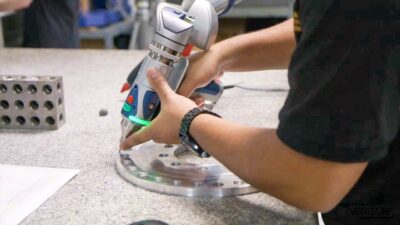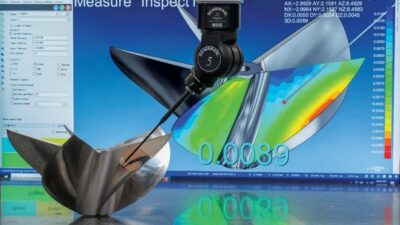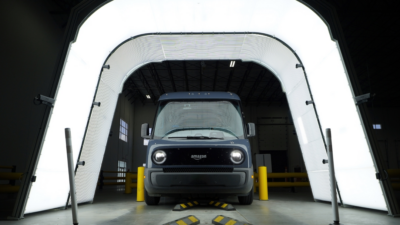From cutting downtime to spotting defects, here are three ways artificial intelligence can improve your QC.
With the rise of large language models (LLMs) into the public consciousness, the artificial intelligence (AI) hype cycle has reached a peak once again and it seems like everyone—from Microsoft to The Beatles—is trying to get in on the action.
But we shouldn’t let these fancy new versions of predictive text obscure the fact that AI has been around and in development for decades, with numerous productive advances that predate ChatGPT and its ilk. There’s no better way to separate hype from reality when it comes to AI than by taking a look at some of the practical ways it’s being used in manufacturing, and more specifically in quality control (QC).
From machine vision to predictive analytics, here are three ways to use AI for QC. These are presented in descending order of maturity, i.e., the first example is already being deployed in practical applications, the second is mostly still in the pilot phase and the third is, at this point, mostly conceptual.
Unlike LLMs, which have an uncertain future at best, artificial intelligence in quality control has already proven to be productive, with many more applications to grow into. Whether and what effect it will have on the future of the manufacturing workforce remains to be seen but, whatever happens, it’s certainly an interesting time to be a quality professional.
#1 Machine Vision
Machine vision is a form of industrial automation utilized for inspection, sorting and robot guidance. The idea is to use a combination of lighting, cameras and software to extract information from a captured image. This information can be as simple as a go/no-go signal or as complex as the identity, orientation and position of each object in the image.
While machine vision doesn’t involve AI per se, the two technologies are becoming more closely intertwined as developers turn to neural networks in order to augment machine-vision algorithms and improve their accuracy. Audi, for example, has begun using AI for quality control of spot welds at its Neckarsulm plant in Germany. Prior to deploying machine vision, employees had to check the quality of welds manually using ultrasound, with samples drawn randomly.
Audi’s head of production planning, automation and digitization has claimed elsewhere that using machine vision with AI reduced the labor costs associated with these inspections by 30-50 percent. As such, it should come as no surprise that Volkswagen Group is rolling out the technology in Audi’s Brussels factory, the Volkswagen plant in Emden and Audi headquarters in Ingolstadt. All that’s required is to retrain the AI model for the different weld settings in each of these locations.
#2 Root Cause Analysis
The goal of improving manufacturing quality can be fulfilled in two complementary ways: by detecting defects in products and by identifying the source of those defects in the production process. As the example above makes clear, AI can assist in the first task by augmenting machine vision. The second task, more formally known as root cause analysis (RCA), can also benefit from the use of artificial intelligence.
Traditional RCA methodologies include Pareto analysis, fishbone diagrams and the five whys, among others. While these remain essential tools for quality professionals, they also require considerable knowledge and expertise in order to be used most effectively. This presents a problem for manufacturers staring down the barrel of the skills gap, worrying that their best quality people (in both senses of the term) will soon be retiring. When this risk is combined with the fact that manufacturers are producing more data than ever, an opportunity to deploy artificial intelligence as a solution seems only natural.
Here’s the basic idea: take all of your manufacturing process and product data and feed it to a machine learning model (typically, more than one). Through training, the model(s) will eventually recognize the correlates of product defects in the process data (e.g., a variation in the speed or feed of a CNC lathe that correlates with a gear not fitting properly into an assembly). Ideally, this entire procedure will happen in real time, giving manufacturing engineers enough of a heads-up that they can intervene in the process and avoid have to scrap or rework expensive parts.
#3 Supply Chain Management
Precipitated by the COVID-19 pandemic, the ongoing struggles of the global supply chain are continuing to impact manufacturers at virtually every stage of the product lifecycle. Amidst natural disasters brought on by climate change and geopolitical upheavals like Russia’s invasion of Ukraine, the availability of essential parts and materials seems less predictable than ever.
The recent shortage of microprocessors and its effect on the automotive industry is a prime example of how disruptions at one point in the supply chain can bring about serious consequences downstream. However, as with the other examples discussed in this article, managing supply chains is a task to which AI is particularly well suited. The combination of large volumes of data and a need to optimize across multiple parameters is what makes supply chain management such a tractable problem for AI.
By integrating the data from manufacturing execution systems (MES) and enterprise resource planning (ERP), machine learning models can forecast product demand and the availability of raw materials. There are myriad ways this integration can benefit manufacturers, from better data quality to enhancing cybersecurity. However, in the context of manufacturing quality, by putting this information together with supplier performance data, including delivery times and pricing, manufacturers can use AI to ensure consistent product quality across their entire supply chain.



